Guest editor Ole Scheeren’s Archipelago Cinema, Venice
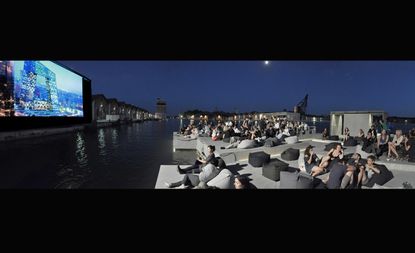
One of our trio of esteemed guest editors for the October issue, architect Ole Scheeren also dipped his toe in the waters of Venice during this year's 13th Architecture Biennale. The Archipelago Cinema, first seen moored in a steep cove on the Thai island of Yao Noi, was recreated and reborn as a venue in Venice, thanks to the flexibility of the original design and involvement of local craftspeople.
Formed from a series of rafts, lashed together with a grid of scaffolding, then clad with suitably maritime decking, the Cinema was then set adrift in the middle of the Arsenale basin, accessible only by water taxi. Strewn with comfy beanbags and the sparkling covers of our ultra-strict limited edition of Scheeren's guest-edited section of the magazine, the floating structure was the perfect alfresco setting for architecture films, screened over several days.
As the clear skies faded to stars on the opening night, the projector rolled and the drinks from Belvedere Vodka and Peroni Beer were doled out to the plucky guests. The aftershow party, with kind support from the KT Wong Foundation and our good selves, saw the platform shimmy to the sleek sound and vision created by Marc Feigenspann, Johannes Brecht and VJ Philipp Monjoie.
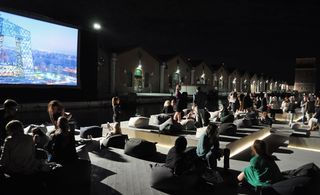
Strewn with benches and comfy beanbags, the floating structure was the perfect alfresco setting for architecture films screened over several days
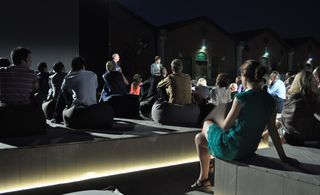
Formed from a series of rafts, lashed together with a grid of scaffolding, then clad with suitably maritime decking, the cinema was set adrift in the middle of the Arsenale basin, accessible only by water taxi. Here Ole Scheeren introduces the evening ahead
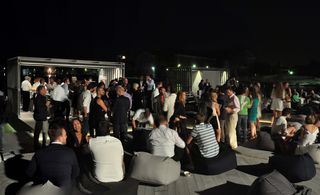
The aftershow party was co-hosted by Wallpaper* and the KT Wong Foundation
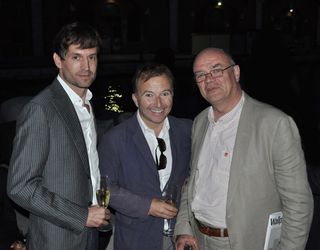
Architect and Wallpaper* guest editor Ole Scheeren, Wallpaper* Editor-in-Chief Tony Chambers and Barbican managing director Sir Nicholas Kenyon
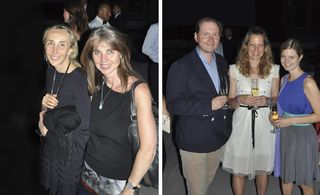
10 Corso Como-founder Carla Sozzani, and former Condé Nast Traveller editor Sarah Miller; Wallpaper* editorial director Richard Cook, WWD's Samantha Conti and The Daily Telegraph's Georgia Dehn
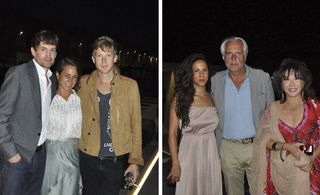
Ole Scheeren, jewellery designer Delfina Delettrez and publisher Jefferson Hack; Publicist Laura Colapietro, V&A director Martin Roth and KT Wong Foundation founder Lady Linda Wong Davies

Music came courtesy of Marc Feigenspann, Johannes Brecht and VJ Philipp Monjoie
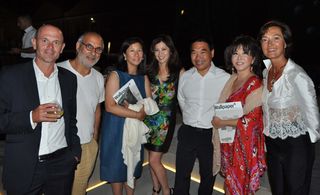
Guests, including BBC creative director Alan Yentob (second from left), were given limited edition books of Scheeren's guest-edited section of our October issue

The book is fronted by a graphic, foil-blocked image of the floating cinema, seen from above

As Wallpaper* guest editor, Ole Scheeren has brought together artists and writers from Beijing, Bangkok, Singapore and Kuala Lumpur - all cities where his practice works - for a unique take on Asia's incredible urban life

Scheeren, photographed by Mei Yuan Gui, with a model of his Angkasa Raya skyscraper, now under construction in Kuala Lumpar, Malaysia

Valerie Stahl works as a photographer and artist in Berlin but fell in love with China and the rest of Asia after first coming to work on a commission for Scheeren in Beijing in 2008. The book includes works from her 'International Building Collages' series, Part I (Singapore), including 'The Scotts Tower', 2012
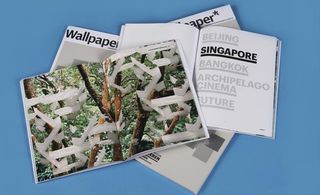
'International Building Collages' series, Part I (Singapore), 'The Interlace', 2012,
by Valerie Stahl
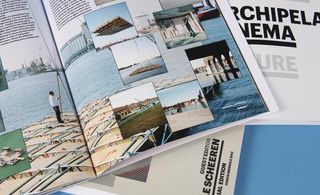
The platforms of the floating cinema are put in place in the Venetian lagoon
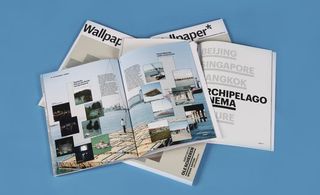
The cinema, photographed on its first outing in Yao Noi, Thailand (left), and under construction in Venice
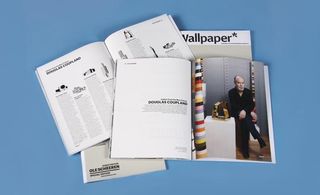
Canadian novelist, visual artist and designer Douglas Coupland contributed 'Letters from the Near Future' to Scheeren's guest edited section. Here, he is photographed in his Vancouver studio with his polished brass sculpture of the CCTV Tower
Wallpaper* Newsletter
Receive our daily digest of inspiration, escapism and design stories from around the world direct to your inbox
Jonathan Bell has written for Wallpaper* magazine since 1999, covering everything from architecture and transport design to books, tech and graphic design. He is now the magazine’s Transport and Technology Editor. Jonathan has written and edited 15 books, including Concept Car Design, 21st Century House, and The New Modern House. He is also the host of Wallpaper’s first podcast.
-
 The moments fashion met art at the 60th Venice Biennale
The moments fashion met art at the 60th Venice BiennaleThe best fashion moments at the 2024 Venice Biennale, with happenings from Dior, Golden Goose, Balenciaga, Burberry and more
By Jack Moss Published
-
 Crispin at Studio Voltaire, in Clapham, is a feast for all the senses
Crispin at Studio Voltaire, in Clapham, is a feast for all the sensesNew restaurant Crispin at Studio Voltaire is the latest opening from the brains behind Bistro Freddie and Bar Crispin, with interiors by Jermaine Gallagher
By Billie Brand Published
-
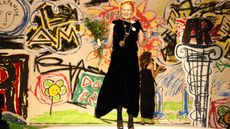 Vivienne Westwood’s personal wardrobe goes up for sale in landmark Christie’s auction
Vivienne Westwood’s personal wardrobe goes up for sale in landmark Christie’s auctionThe proceeds of ’Vivienne Westwood: The Personal Collection’, running this June, will go to the charitable causes she championed during her lifetime
By Jack Moss Published
-
 Giovanni Michelucci’s dramatic concrete church in the Italian Dolomites
Giovanni Michelucci’s dramatic concrete church in the Italian DolomitesGiovanni Michelucci’s concrete Church of Santa Maria Immacolata in the Italian Dolomites is a reverently uplifting memorial to the victims of a local disaster
By Jonathan Glancey Published
-
 Milan’s 10 Corso Como revamp nods to the concept store’s industrial character
Milan’s 10 Corso Como revamp nods to the concept store’s industrial characterMilanese concept store 10 Corso Como unveils its new look by 2050+, a stripped-back design that nods to its 20th-century character
By Ellie Stathaki Published
-
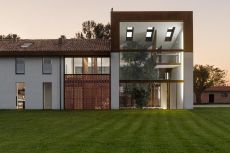 Carlo Ratti announced curator of Venice Architecture Biennale 2025
Carlo Ratti announced curator of Venice Architecture Biennale 2025Carlo Ratti has been revealed as the Director of the Architecture Department at the Venice Architecture Biennale 2025, with the specific task of curating the 19th International Architecture Exhibition
By Ellie Stathaki Published
-
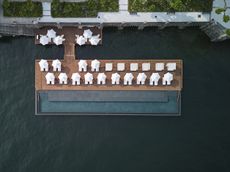 Floating infinity pool by Herzog & De Meuron at Lake Como is largest of its kind
Floating infinity pool by Herzog & De Meuron at Lake Como is largest of its kindHerzog & de Meuron creates the largest floating infinity pool in the world for Mandarin Oriental in Lake Como
By Lauren Ho Published
-
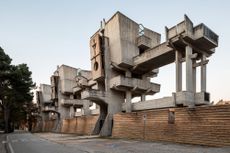 Best of brutalist Italian architecture chronicled in new book
Best of brutalist Italian architecture chronicled in new bookBrutalist Italian architecture enthusiasts and concrete completists will be spoilt for choice by Roberto Conte and Stefano Perego’s pictorial tour
By Jonathan Bell Published
-
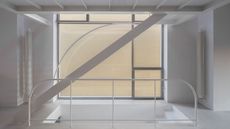 Studio Tropicana, Switzerland and Italy: Wallpaper* Architects’ Directory 2023
Studio Tropicana, Switzerland and Italy: Wallpaper* Architects’ Directory 2023Based in Switzerland and Italy, Studio Tropicana is part of the Wallpaper* Architects’ Directory 2023, our annual round-up of exciting emerging architecture studios
By Ellie Stathaki Published
-
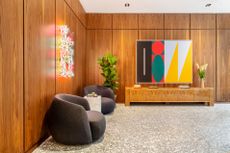 WeWork Meravigli blends past and present in a 21st-century office space
WeWork Meravigli blends past and present in a 21st-century office spaceWeWork Meravigli launches in Milan, bringing its ornate, historical new home to the 21st century
By Ellie Stathaki Published
-
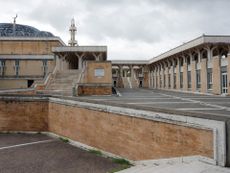 In memoriam: Paolo Portoghesi (1931 - 2023)
In memoriam: Paolo Portoghesi (1931 - 2023)Postmodernist Italian architect Paolo Portoghesi has died; writer David Plaisant celebrates his life and legacy, recalling his visit to Calcata for a feature in the Wallpaper* April 2021 issue
By David Plaisant Published